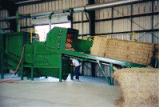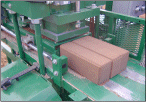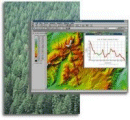Sustainable Technologies
As we are working on sustainable development projects in different countries, ICSD identify new technologies that can help us to achieve sustainability. You can find some of the best technologies existed on this page.
For more information on these technologies, please contact ICSD at: info@solarcities.org.
The Center is dedicated to promote new, efficient, cost-effective technologies for sustainable development. Currently, ICSD is working with the following technologies:
Distributed Generation & Combined Heat and Power
The Distributed Generation (DG) system is a new way to supply continuous energy to facility. It can be installed inside or near a building to provide electricity and optionally, heat. DG can help the customer save money in buying energy, reduce environmental impacts, and avoid power outages. DG integrates the Combined Heat and Power (CHP) technology to cogenerate heat during the electricity production, to provide heating, cooling and power to facilities such as factories, greenhouse, and hospital. More information, please contact ICSD.
Back to Top
Solar Power Technologies
 After a few decades of development, solar power technology has greatly increased its productivity while significantly reduced its cost. ICSD is working to use solar energy technologies to power water pumping, drying, small electric tools, communication, and education. Integrating these new technologies in building schools, clinics, and houses helps rural or distant areas to gather energy at a reasonable price. It also benefits the local economy greatly.
After a few decades of development, solar power technology has greatly increased its productivity while significantly reduced its cost. ICSD is working to use solar energy technologies to power water pumping, drying, small electric tools, communication, and education. Integrating these new technologies in building schools, clinics, and houses helps rural or distant areas to gather energy at a reasonable price. It also benefits the local economy greatly.
ICSD has a good relationship with non-profit organizations such as Solar Energy Industries Association and Solar Energy Research and Education Foundation. Together we promote cleaner, safer, more efficient, and cost-effective energy solutions, including solar, wind, and hydroelectric power.
Back to Top
Straw Board - The Solution to Burning Straw
 Burning straw in the fields after harvesting has been a major environmental problem in many countries, especially developing countries such as China. The smoke and dust released by the burning pollutes the air, cause health problems, and reduce the solar radiation thus decrease the agricultural production.
Burning straw in the fields after harvesting has been a major environmental problem in many countries, especially developing countries such as China. The smoke and dust released by the burning pollutes the air, cause health problems, and reduce the solar radiation thus decrease the agricultural production.
The Enviro Board Corporation developed and patented a fiber extrusion process that produces a low-cost fiberboard suitable for home and building construction, plus many other uses, such as wall panels, door cores, office partitions, freeway sound walls. The process eliminates the need to burn agricultural waste and produces an environmental friendly building material.
Want to know more? Download Straw Board's Flyer! or visit Enviro Board Corporation.
Back to Top
TerraBuilt™ Earth Brick - Water-free Building System
 With a GreenMachine™, common earth and only a little mortar, anyone can produce and use the Earth Brick for construction. This technology advances the traditional adobe building method to a brand new stage. Central to the TerraBuilt™ construction concept is the ability to rapidly produce on-site a dimensionally precise tongue and groove structural block. It reduces construction costs by using abundantly available local material and labor, and by eliminating time consuming construction processes. It also largely eliminates the use of mortar, thus reduces the need for mining for mortar, which destroys the top soil.
With a GreenMachine™, common earth and only a little mortar, anyone can produce and use the Earth Brick for construction. This technology advances the traditional adobe building method to a brand new stage. Central to the TerraBuilt™ construction concept is the ability to rapidly produce on-site a dimensionally precise tongue and groove structural block. It reduces construction costs by using abundantly available local material and labor, and by eliminating time consuming construction processes. It also largely eliminates the use of mortar, thus reduces the need for mining for mortar, which destroys the top soil.
Want to know more? Download Earth Brick's Flyer! or visit Forfire Associates.
Back to Top
Geographic Information System (GIS)
 GIS technology combines powerful database capabilities for spatial data, with the unique visual perspective of a good old-fashioned map. It is a system of computer software, hardware, data, and personnel to help manipulate, analyze and present information that is tied to a spatial location. GIS can help urban planners, environmental scientists, economists, engineers, and local government to improve organizational integration, make better decisions and map any data.
GIS technology combines powerful database capabilities for spatial data, with the unique visual perspective of a good old-fashioned map. It is a system of computer software, hardware, data, and personnel to help manipulate, analyze and present information that is tied to a spatial location. GIS can help urban planners, environmental scientists, economists, engineers, and local government to improve organizational integration, make better decisions and map any data.
There are numerous application of GIS in sustainable development. We can use it to study and manage eco-system, track the effects of pollution, locate sustainable facilities, manage natural and renewable resources, design transportation and energy system, study demographics and growth pattern, monitor environmental quality, etc.
Back to Top
Waste Water Reclamation & Reuse System (WWRR)
 This circular waste water treatment system is based on the ecological principle that each material has its own place on the Earth. To eliminate the need for storing pollutants, we must minimize the pollutants we produce. WWRR collects waste water into one or more deep aerated cells to purify. The water after purification can be used to irrigate farms and gardens. The whole system can be designed and planned with the community, and becomes a scenery spot to the residents.
This circular waste water treatment system is based on the ecological principle that each material has its own place on the Earth. To eliminate the need for storing pollutants, we must minimize the pollutants we produce. WWRR collects waste water into one or more deep aerated cells to purify. The water after purification can be used to irrigate farms and gardens. The whole system can be designed and planned with the community, and becomes a scenery spot to the residents.
Want to know more? Download WWRR's Flyer!
Back to Top


 After a few decades of development, solar power technology has greatly increased its productivity while significantly reduced its cost. ICSD is working to use solar energy technologies to power water pumping, drying, small electric tools, communication, and education. Integrating these new technologies in building schools, clinics, and houses helps rural or distant areas to gather energy at a reasonable price. It also benefits the local economy greatly.
After a few decades of development, solar power technology has greatly increased its productivity while significantly reduced its cost. ICSD is working to use solar energy technologies to power water pumping, drying, small electric tools, communication, and education. Integrating these new technologies in building schools, clinics, and houses helps rural or distant areas to gather energy at a reasonable price. It also benefits the local economy greatly. 
 With a GreenMachine™, common earth and only a little mortar, anyone can produce and use the Earth Brick for construction. This technology advances the traditional adobe building method to a brand new stage. Central to the TerraBuilt™ construction concept is the ability to rapidly produce on-site a dimensionally precise tongue and groove structural block. It reduces construction costs by using abundantly available local material and labor, and by eliminating time consuming construction processes. It also largely eliminates the use of mortar, thus reduces the need for mining for mortar, which destroys the top soil.
With a GreenMachine™, common earth and only a little mortar, anyone can produce and use the Earth Brick for construction. This technology advances the traditional adobe building method to a brand new stage. Central to the TerraBuilt™ construction concept is the ability to rapidly produce on-site a dimensionally precise tongue and groove structural block. It reduces construction costs by using abundantly available local material and labor, and by eliminating time consuming construction processes. It also largely eliminates the use of mortar, thus reduces the need for mining for mortar, which destroys the top soil.  GIS technology combines powerful database capabilities for spatial data, with the unique visual perspective of a good old-fashioned map. It is a system of computer software, hardware, data, and personnel to help manipulate, analyze and present information that is tied to a spatial location. GIS can help urban planners, environmental scientists, economists, engineers, and local government to improve organizational integration, make better decisions and map any data.
GIS technology combines powerful database capabilities for spatial data, with the unique visual perspective of a good old-fashioned map. It is a system of computer software, hardware, data, and personnel to help manipulate, analyze and present information that is tied to a spatial location. GIS can help urban planners, environmental scientists, economists, engineers, and local government to improve organizational integration, make better decisions and map any data. This circular waste water treatment system is based on the ecological principle that each material has its own place on the Earth. To eliminate the need for storing pollutants, we must minimize the pollutants we produce. WWRR collects waste water into one or more deep aerated cells to purify. The water after purification can be used to irrigate farms and gardens. The whole system can be designed and planned with the community, and becomes a scenery spot to the residents.
This circular waste water treatment system is based on the ecological principle that each material has its own place on the Earth. To eliminate the need for storing pollutants, we must minimize the pollutants we produce. WWRR collects waste water into one or more deep aerated cells to purify. The water after purification can be used to irrigate farms and gardens. The whole system can be designed and planned with the community, and becomes a scenery spot to the residents.